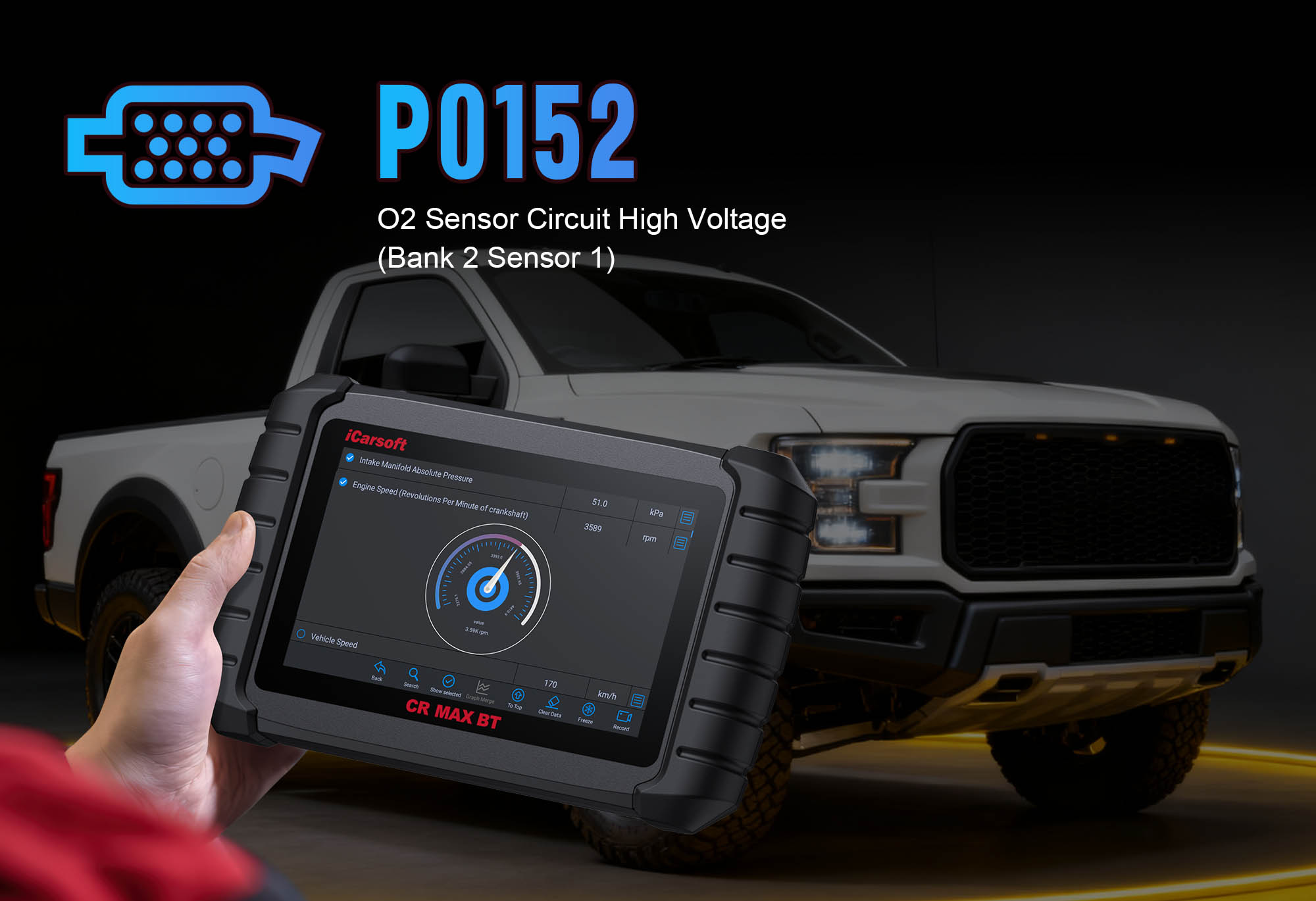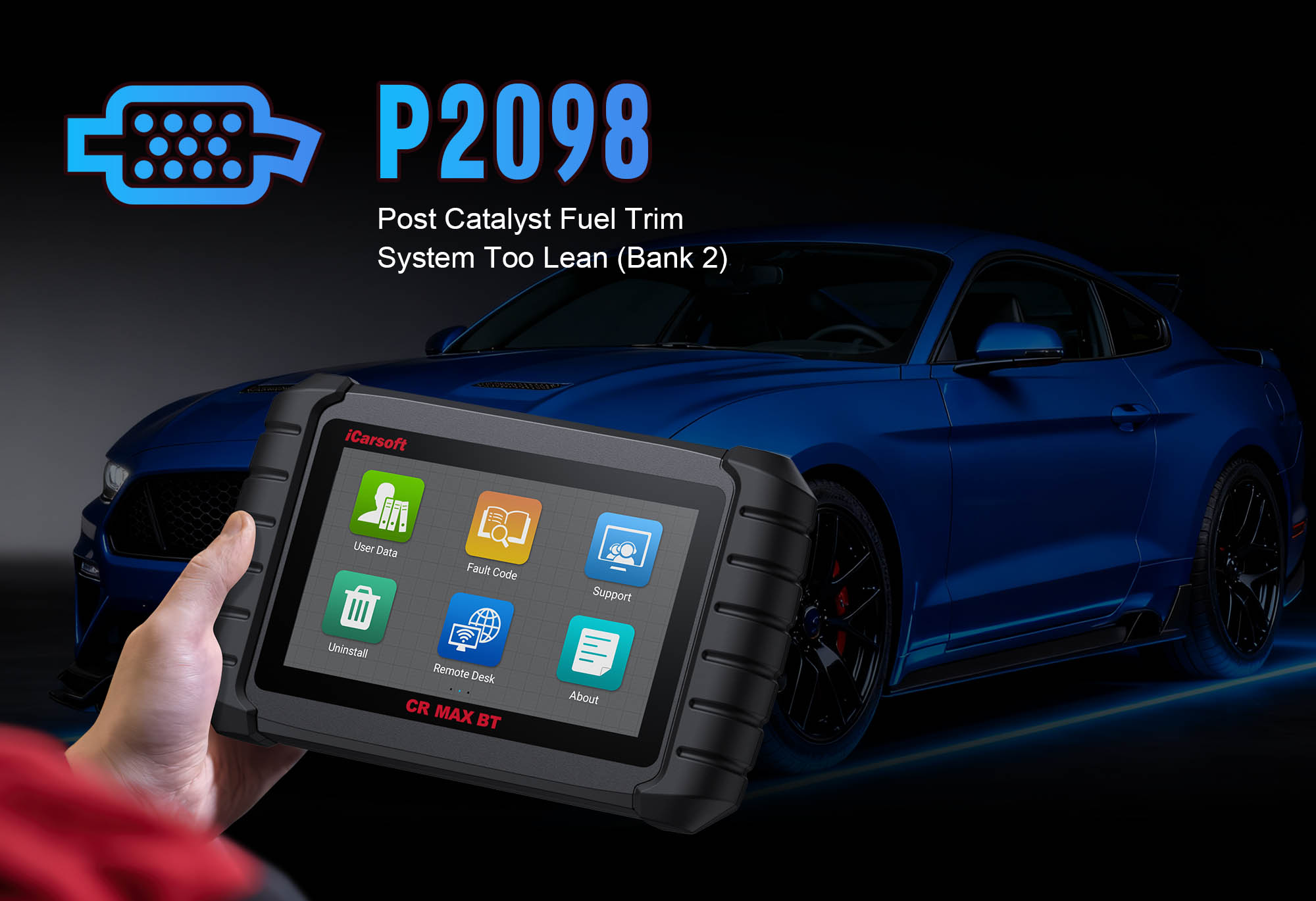Diagnose & Clear P0152 with iCarsoft CR MAX BT: Fix O2 Sensor Circuit High Voltage (Bank 2, Sensor 1)
Diagnose & Clear P0152 with iCarsoft CR MAX BT
If your vehicle’s check engine light stays on, you notice poor fuel economy, or it fails an emissions test, a diagnostic scan will likely return P0152. This OBD-II code stands for "Oxygen (O2) Sensor Circuit High Voltage – Bank 2, Sensor 1"—a fault targeting the upstream O2 sensor. The upstream sensor is mounted before the catalytic converter on cylinder bank 2.
The O2 sensor measures exhaust gas oxygen levels to help the Engine Control Module (ECM) adjust air-fuel ratios. When it sends abnormally high voltage signals (typically above 0.9V), the ECM misinterprets rich fuel mixtures, leading to inefficient combustion, increased emissions, and potential catalyst damage. Basic scanners can’t isolate faults, but the iCarsoft CR MAX BT with specialized O2 sensor diagnostics solves this. Let’s break down how to resolve P0152 step by step.
Understanding P0152: Symptoms & Causes
The upstream O2 sensor (Bank 2, Sensor 1) generates voltage based on exhaust oxygen: ~0.1V for lean mixtures (too much air) and ~0.9V for rich mixtures (too much fuel). It fluctuates 10–20 times per second normally. P0152 triggers when voltage stays above 0.9V long-term, indicating a sensor or circuit issue.
Key Symptoms of P0152
-
Illuminated Check Engine Light (CEL): A steady CEL turns on, and some vehicles display "Emissions System Warning" or "Catalyst Efficiency Low."
-
Poor Fuel Economy: The ECM adds extra fuel to "correct" perceived lean mixtures, dropping mileage by 15–25%.
-
Increased Emissions: Rich mixtures produce excess hydrocarbons (HC) and carbon monoxide (CO), causing failed emissions tests.
-
Catalyst Overheating Risk: Unburned fuel in exhaust overheats the catalytic converter, leading to meltdown and costly replacement.
-
Rough Idling: Erratic air-fuel ratios cause unstable idle, especially when the engine is warm.
Common Causes of P0152
|
Cause
|
Description
|
|
Faulty O2 Sensor
|
Internal heater failure or worn sensing element (common after 60,000–100,000 miles) causes stuck high voltage.
|
|
Damaged Sensor Wiring
|
Frayed wires, rodent chew marks, or corrosion in power/ground/signal lines create shorts, spiking voltage.
|
|
Loose/Corroded Connector
|
The sensor’s 4–5 pin connector (near exhaust manifold) becomes loose, rusted, or moist—disrupting signal flow.
|
|
Exhaust Leaks
|
Leaks before the O2 sensor draw in extra oxygen; the ECM enriches fuel, causing high voltage.
|
|
Blown O2 Sensor Fuse
|
A dedicated "O2 Heater" or "Sensor Power" fuse in the under-hood box blows, affecting sensor heating and voltage.
|
|
ECM Malfunction
|
Rarely, the ECM’s internal O2 signal processing circuit fails—incorrectly interpreting voltage levels.
|
Why iCarsoft CR MAX BT Excels at Diagnosing P0152
The CR MAX BT outperforms basic tools with features tailored to O2 sensor diagnostics—critical for accuracy. Here’s its key value:
Wireless Bluetooth Connectivity
Test Bank 2, Sensor 1 (near hot exhaust) from 30 feet away—no cords risk burns or limit access.
Live Voltage & Response Tracking
Monitors real-time voltage (0.1V–0.9V normal) and fluctuation frequency—flags stuck high voltage instantly.
O2 Sensor Heater Test
Checks if heater reaches 700–800°F in 30 seconds—heater failure is a top P0152 cause.
Exhaust Leak Detection
Compares Bank 2, Sensor 1 to other O2 sensors—highlights irregularities from leaks.
AutoVIN Identify
Automatically detects vehicle make/model and O2 specs (heater voltage, pinouts) in seconds—no manual lookup.
Step-by-Step: Diagnose & Clear P0152 with iCarsoft CR MAX BT
-
Safety First & Visual Inspection
1. Cool the engine: Let the vehicle sit 1–2 hours after driving to avoid exhaust burns.
2. Locate the sensor: Use Component Location > Engine > Exhaust System > O2 Sensor (Bank 2, Sensor 1) (Bank 2 = opposite Bank 1; Sensor 1 = upstream).
3. Inspect connector: Disconnect (flathead to release clips), check corrosion/bent pins—clean with contact cleaner, apply dielectric grease.
4. Inspect wiring: Follow harness to ECM, check frays/heat damage—repair with heat-shrink; replace if severe.
5. Check exhaust leaks: Visually inspect manifold/pipes for rust/cracks; listen for ticking when engine runs.
-
Connect the Tool & Confirm P0152
Plug CR MAX BT into OBD-II port, power on, select AutoVIN Identify to retrieve specs. Navigate to Engine > Fault Codes > Read Codes to confirm P0152. Tap Code Details for vehicle-specific insights (e.g., "Chevrolet Silverado: O2 High Voltage; Expected 0.1–0.9V, Actual 1.0V"), and check related codes (e.g., P0132, P0153).
-
Monitor Live O2 Sensor Data
Start engine, idle 10 minutes (warms sensor). Navigate to Engine > Live Data > O2 Sensors > Bank 2, Sensor 1:
- Voltage: Should fluctuate 0.1V–0.9V; steady >0.9V confirms P0152.
- Response rate: Healthy sensors fluctuate 10–20 times/second; flat line = faulty sensor.
- Compare to Bank 1, Sensor 1: Similar high voltage on both = possible fuel system issue (not just O2 sensor).
-
Test O2 Sensor Heater & Circuit Integrity
1. Heater circuit test: Navigate to Special Functions > Engine > O2 Sensor Heater Test > Bank 2, Sensor 1. Tool monitors current (0.5–1.5A normal); "Heater Not Responding" = failed heater/broken wire.
2. Circuit checks (engine off, connector disconnected):
- Power wire: Set multimeter to "DC Voltage"—touch heater power pin + ground. Ignition "ON" = 12V; 0V = blown fuse/broken wire.
- Ground wire: Set to "Ohms"—touch heater ground pin + chassis ground. Normal = <1 ohm; higher = poor ground.
- Signal wire: Check continuity between signal pin and ECM (use wiring diagram)—no continuity = broken wire.
-
Test the O2 Sensor & Exhaust Leaks
1. O2 sensor bench test (if replacing):
- Remove sensor with O2 socket (torque 30–35 ft-lbs per Torque Specs).
- Check heater resistance (between heater pins): 10–40 ohms normal; infinite = failed heater.
2. Exhaust leak verification:
- Start engine, spray soapy water on suspect leaks (manifold gaskets, pipe joints); bubbles = leak.
- Fix leaks with new gaskets/welds, then retest O2 voltage—normal fluctuations = leak was cause.
-
Repair & Clear P0152
- Exhaust leaks/blown fuse: Repair leaks with new gaskets; replace fuse with OEM-compatible one (check Fuse Guide for amperage).
- Wiring/connector: Repair frays; clean connectors with dielectric grease; replace damaged harness.
- Faulty O2 sensor: Replace with OEM-equivalent (use Part Lookup—e.g., Bosch 17018 for Ford, Denso 234-4001 for Toyota); torque to specs.
- ECM malfunction: Consult dealer for reprogramming/replacement (last resort—confirm with ECM Communication Test).
Clear code: Go to Engine > Fault Codes > Clear Codes to delete P0152.
-
Validate the Repair
1. Monitor data: Confirm Bank 2, Sensor 1 voltage fluctuates 0.1V–0.9V with healthy response rate.
2. Test drive: Operate 30–40 minutes (include highway) — ensure CEL stays off, fuel economy improves.
3. Emissions pre-test: Run I/M Readiness Test to verify O2 sensor monitor is "Ready" (critical for inspections).
4. Save report: Use History & Report to document fault, repairs, and post-repair data.
Preventing P0152 Recurrence
-
Regular O2 Sensor Checks: Use Service Reminder to test Bank 2, Sensor 1 every 50,000 miles—catch early heater wear/slow response.
-
Fuel System Maintenance: Replace fuel filters and clean injectors every 30,000 miles (per Maintenance Schedule)—dirty injectors stress O2 sensors.
-
Exhaust Inspections: Check for leaks every 15,000 miles (use live data to compare sensor readings between banks).
-
Lifetime Free Updates: Use One-Key Upgrade (Wi-Fi) to add new O2 sensor diagnostic features.
Conclusion
P0152’s high-voltage O2 sensor fault risks catalyst damage and wasted fuel, but the iCarsoft CR MAX BT simplifies diagnosis with wireless convenience, live tracking, and heater tests. Whether you’re a DIYer or pro, this tool ensures you fix the root cause (sensor, leak, or wiring) instead of guessing.
With global vehicle coverage and 40+ service functions, the CR MAX BT is a long-term investment. Restore accurate air-fuel control, improve mileage, and avoid costly catalyst repairs—all with one professional-grade diagnostic tool.





